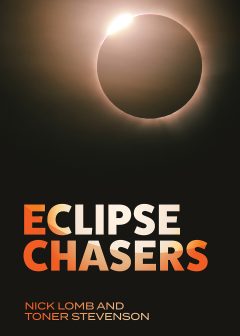Eclipse chasers (ed. Nick Lomb & Toner Stevenson)
| By Ed. Nick Lomb & Toner Stenenson | Reviewed by Mike Frost |
| CSIRO Publishing 2023 | 216 pages |
| Price £28.95 | ISBN:9781486317073 |

I love Australia. I worked there for a year (1987–’88) in Wollongong, New South Wales, and returned to Oz to view the total solar eclipse of 2012 December from Palm Cove, Queensland. I hope to return again in 2023 April to see the next such eclipse, which brushes the coast of Western Australia. This is the first of five total solar eclipses visible from Australia in under sixteen years, so I may well be making more visits!
Dr Toner Stevenson of the University of Sydney and Prof Nick Lomb of the University of Southern Queensland both used to work at the Sydney Observatory museum (close to the Harbour Bridge and well worth a visit); both are members of the Sydney City Skywatchers (formerly the BAA New South Wales Branch) and both are veteran eclipse chasers. They wanted to create a guide to these eclipses, placing them in a historical context as well as explaining where, when, and how to view them.
The historical accounts are fascinating. Prof Duane Hamacher, who has published extensively on First Nations astronomy, and Uncle Ghillar Michael Anderson of the Euahlayi people survey the astronomical legends and the eye-witness accounts of Australia’s aboriginal peoples. Nick Lomb writes on the total eclipses of 1857 (total from Sydney but clouded out) and 1871, when a scientific expedition, uniting the Australian colonies, travelled to Cape York in Far North Queensland.
My favourite historical chapter is Toner Stevenson’s account of the 1922 eclipse, when several scientific expeditions visited Western Australia in an attempt to replicate the famous observations of the 1919 total eclipse, which validated Einstein’s theory of General Relativity. Among the scientists who travelled to Wallal was Mary Evershed of the Kodaikanal Observatory, India, my predecessor and first Director of the BAA Historical Section.
The next chapter tells the story of Australia’s 20th-century eclipses, including some of the first commercial eclipse flights. Nick Lomb and Melissa Hulbert then share their accounts of the Aussie eclipses of 2002 and 2012.
A final chapter by Kirsten Banks, Melissa Hulbert and Geoffrey Wyatt provides an introduction to the science of eclipses (I thought this part might have been better placed at the start of the book), tips on how best to observe them safely and fruitfully, and an outline of where to see each of the five upcoming events. There is a short ‘for teachers’ section, suggesting educational projects based around eclipses, and a comprehensive glossary, with the first use of each term in the text in bold to indicate that a definition is available. I spotted only very minor typos and found nothing to disagree with on the science.
Umbraphiles who are planning an eclipse trip to this extraordinary part of the world will enjoy this book, I am sure. Historians of astronomy will find a lot to interest them, too.
Mike Frost is Director of the Historical Section. He hopes to see his fourteenth total eclipse from Exmouth, Western Australia, on 2023 Apr 20.
| The British Astronomical Association supports amateur astronomers around the UK and the rest of the world. Find out more about the BAA or join us. |
